Wi-Fi 6E: The Next Great Chapter in Wi-Fi White Paper
Available Languages
Bias-Free Language
The documentation set for this product strives to use bias-free language. For the purposes of this documentation set, bias-free is defined as language that does not imply discrimination based on age, disability, gender, racial identity, ethnic identity, sexual orientation, socioeconomic status, and intersectionality. Exceptions may be present in the documentation due to language that is hardcoded in the user interfaces of the product software, language used based on RFP documentation, or language that is used by a referenced third-party product. Learn more about how Cisco is using Inclusive Language.
In April 2020 the Federal Communications Commission (FCC) announced the opening of the 6 GHz band for Wi-Fi and other unlicensed uses. This announcement is a good thing, and arguably one of the best things to happen in Wi-Fi since Wi-Fi 6 and Orthogonal Frequency-Division Multiple Access (OFDMA) came about.
For some perspective on why this is such a milestone event for Wi-Fi, it should be noted that from its U.S. beginnings in 1985 all the way to the present, Wi-Fi has been granted a total of just 583 MHz of spectrum in both the 2.4 and 5 GHz bands combined. This spectrum accrual took place in multiple separate grants over the years. Wi-Fi has steadily grown in popularity and provides demonstrable economic benefit. Wi-Fi’s capabilities have also grown, and as a result, its use in the 2.4 and 5 GHz bands has reach its limits.
In April 2020, 35 years into this “experiment in unlicensed use,” a single announcement gave Wi-Fi 1200 MHz of spectrum, more than doubling the current Wi-Fi spectrum allocated in the U.S. The last time Wi-Fi technologies in the U.S. received spectrum from the FCC, it was granted as an experiment in coexistence to align the U.S. channel plans better with other regulatory bodies allowing operations in the U-NII-2c (extended) 5 GHz band. That grant, in 2003, made an additional 240 MHz of spectrum available to Wi-Fi in the U.S. Back then, access points and client devices both required new radios to be able to use this new frequency range. Access points were required to demonstrate an ability to detect and avoid the incumbent user in the band — fixed radar installations. This required implementing Dynamic Frequency Selection (DFS) to ensure that Wi-Fi safely accessed the channels without interfering with existing services.
This paper details the new Wi-Fi 6E band and the rules associated with it.
What does Wi-Fi 6E bring to Wi-Fi?
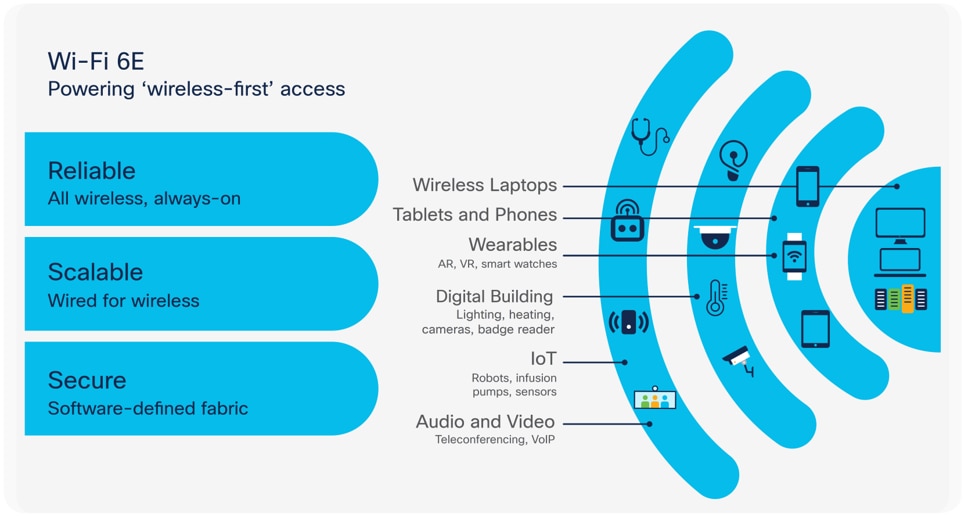
Wi-Fi 6E promotes a wireless-first access approach
The list of goodies is a long one for Wi-Fi 6E:
● Requires Wi-Fi 6 and OFDMA only: no slow legacy devices (802.11a/b/g/n/ac)
● Scheduled: Can segment and implement policy for security and Quality of Experience (QoE)
● Optimized delay: Less than two ms at scale, even in high-density environments
● Incredible bandwidth: Wide channels are easily supported and encouraged.
● Clean RF: Low noise, less congestion
Wi-Fi 6E didn’t just happen overnight, and the solutions it brings have all been studied and largely targeted to solve specific challenges. Wi-Fi has made many advances that have contributed to its growing success over the years. Much as Wi-Fi 6 was created to solve some of the issues inherent with Wi-Fi 1 through 5 operations, Wi-Fi 6E will now implement spectrum rules that favor better Wi-Fi operations. This is the first new spectrum granted for Wi-Fi in the U.S. since the 802.11a (Wi-Fi 3) days. The Wi-Fi 6E specification was designed and implemented to remove the spectrum obstacles that have prevented users from taking advantage of some of the coolest features in Wi-Fi (such as 80 and 160 MHz channels).
The big news, of course, is the 1200 MHz of spectrum between 5.925 GHz and 7.125 GHz, which is known collectively as the 6 GHz band. More subtly, though, an important distinction here is that this is “contiguous” spectrum. That means there are no breaks or gaps in the frequency range from beginning to end. Historically defined ranges for Wi-Fi operations have been added over time as spectrum became available and the need could be demonstrated. Desirable spectrum ranges that aren’t being used are hard to come by, but technologies do change or become obsolete over time. As this happens, spectrum ranges see fewer and fewer primary users, and some ranges eventually get reassigned to other uses. Spectrum is a precious resource, and as Wi-Fi has matured, so has the technology. DFS, for instance, was developed to allow a more cognitive coexistence between Wi-Fi and existing radar systems, allowing 240 MHz (U-NII-2c) to be added for Wi-Fi operations in 2003.
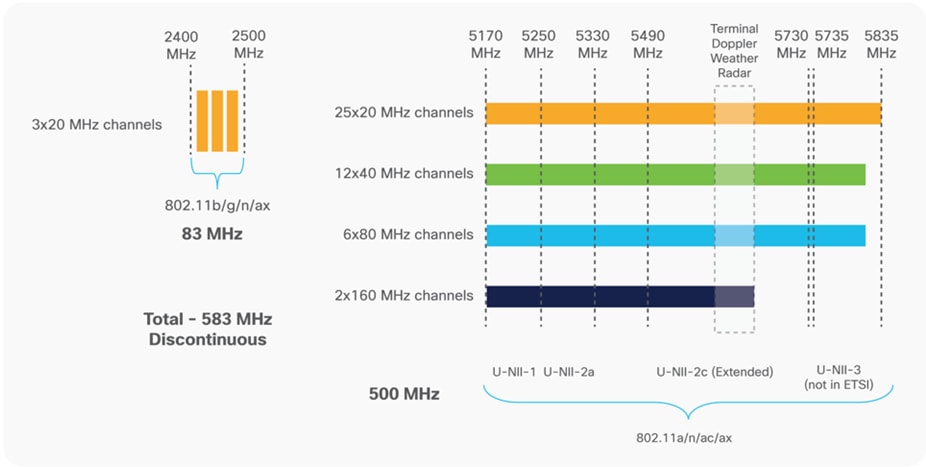
Current 2.4 and 5 GHz spectrum for Wi-Fi
Wi-Fi in the U.S. is permitted to operate in U-NII-1, U-NII-2a, U-NII-2c, and U-NII-3, totaling 500 MHz of 5 GHz bandwidth. However, the ranges leave coverage gaps between the current U-NII ranges. These gaps can be seen in the channel numbers assigned, which jump from 64 to 100 between U-NII-2a and 2c and again between U-NII-2c and 3. As such, Wi-Fi has been operating over a discontinuous range. Beginning with the 802.11n protocol (Wi-Fi 4), a technique called channel bonding allowed two 20 MHz channels to be bonded together to form a single 40 MHz channel. Doubling the channel width almost doubled the throughput of data that could be sent. Just as a wider highway allows more traffic, channel bonding permits more data to be sent during the same time period. However, channel bonding requires that the bonded channel be created from a contiguous frequency range. With the coverage gaps in 5 GHz, this requirement limits how many wide channels can be formed. Additionally, using some of the largest channels leaves frequency ranges that are like scraps; they can’t be combined. In other words, there is wasted spectrum.
Wi-Fi 6E is 1200 MHz of contiguous spectrum that provides seamless coverage across U-NII-5, U-NII-6, U-NII-7, and U-NII-8. With no gaps in coverage for the majority of access classes, this allows for efficient extension of the channel plan regardless of width, with no waste. Wider channels are faster. How much faster? Today, the fastest Wi-Fi 6 data rate is MCS 11 (0.8 microsecond GI). Assuming a client with two spatial streams, MCS 11 will produce the following:
Table 1. Wi-Fi 6 MCS 11, with two spatial streams, comparing throughput by channel width
| Channel Bandwidth |
20 MHz |
40 MHz |
80 MHz |
160 MHz |
| Wi-Fi 6 MCS 11 2SS |
286.8 Mbps |
573.5 Mbps |
1201 Mbps |
2402 Mbps |
The above table doesn’t take into account opportunistic improvements such as Multiuser Multiple-Input Multiple- Output (MU-MIMO) and MU-OFDMA, which can increase the effective throughput, but the point should be clear. If you need 1 Gbps to meet your users’ capacity needs, you need an 80 MHz channel. In 5 GHz today there are only six 80 MHz channels in the U.S. and only five in Europe, and there are even fewer elsewhere in the world. With a limited number of wide channels, supporting more users with more APs exhausts the channel plan sooner. With Wi-Fi 6E, fourteen 80 MHz and seven 160 MHz channels are possible.
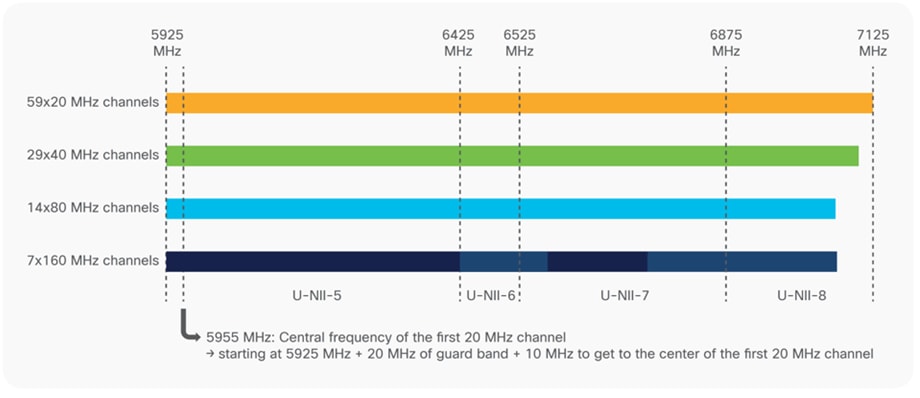
New 6 GHz band with 1200 MHz of contiguous Wi-Fi channel access
Wi-Fi 6E: Finally a greenfield for Wi-Fi?
When Wi-Fi was first introduced, there was only the amazing 802.11b protocol, and operations were limited to the 2.4 GHz spectrum only. As the technology advanced, both the protocols and radio designs changed and Wi-Fi slowly grew into a very mixed environment, with Wi-Fi 1 through 6 now being supported. Arguably, one of the reasons that Wi-Fi has been so successful is the backward compatibility that’s built in to ensure that previous-generation protocols can still be used. Today it’s quite common to find a mix of client types and capabilities operating on the Wi-Fi network.
It turns out that this is suboptimal for two reasons:
● Older clients simply are not as efficient and require a larger share of the air time to send the same amount of data.
● The management protocol overhead needed to maintain backward compatibility often is measurable and contributes to further efficiency losses.
The net result is that figuring out what the capacity will be in a given environment really comes down to the current (often random and variable) mix of client capabilities sharing the cell. Sadly, the answer to the question of how much capacity will be achieved is frequently “it depends on the client mix.”
Wi-Fi 6E does away with the multiprotocol complexities of the past by limiting access to only Wi-Fi 6 and newer protocols in the 6 GHz band. Coupling the Wi-Fi 6 protocol with Wi-Fi 6E spectrum will allow Wi-Fi 6 abilities to shine in an essentially greenfield environment. Wi-Fi 6 provides a deterministic, scheduled MAC and supports network segmentation, outstanding QoE, and optimized latency of under 2 ms one way. This allows a significantly better answer than “it depends.” Newer standards will be admitted over time, such as Wi-Fi 7, which is already being discussed in the IEEE standards body. The differences between newer generations of protocols and the compatibility mechanisms will be more subtle than the quantum shifts experienced from Wi-Fi 1 to Wi-Fi 6. It really is like a “do-over” for Wi-Fi, breaking its chains and moving beyond its history to shine anew.
Wi-Fi was designed from its inception to be a good neighbor and never interfere with other services operating in the same band. Power level restrictions to limit neighbor interference have always been a part of the regulatory rules.
Wi-Fi 6E changes things up a bit and defines four separate access classes for Wi-Fi, each with its own rules:
● Standard Power (Indoor/Outdoor)
● Low Power (Indoor)
● Very Low Power/Portable (Indoor/Outdoor)
● Clients (Indoor/Outdoor)

Wi-Fi 6E access classes and rules
Each of these classes is covered below.
Standard Power (Indoor/Outdoor)
Standard Power is the only access class that supports Wi-Fi 6E AP operations outdoors. Standard Power may also be used indoors as long as all requirements are met. Power is limited to a maximum of 36 dB Effective Isotropic Radiated Power (EIRP), and APs must be coordinated through an Automatic Frequency Coordination (AFC) service. Standard Power is also the only access class limited to operations in U-NII-5 and 7 in the U.S, and as a result gets a total of 850 MHz access.
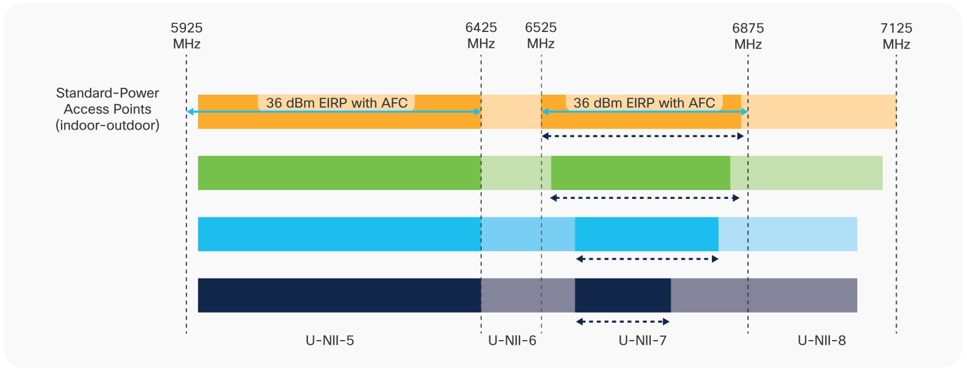
Standard Power spectrum, limited to U-NII-5 and 7
The 6 GHz band comes with some incumbent (licensed) users still operating in it, quite a few actually. Incumbent users in the 6 GHz band include:
● Fixed service: Point-to-point microwave links used for backhauling everything from public safety dispatch systems to cell tower backhaul. There are lots of these in operation today.
● Satellite service: Fixed earth-to-space links as well as mobile space-to-earth links, both common across 6 GHz.
● Television broadcast services: These services are operating in both U-NII-6 and U-NII-8, which are blocked for Standard Power access. They include a variety of mobile technologies used in electronic news gathering and video transfer. Think your local television station’s remote truck and its microwave links to satellites and the station.
● Existing unlicensed users: These include ultra-wide-band users, which operated unlicensed across U-NII-5 through 8 and continue to operate without changes.
Interference with these users must be strictly avoided. U-NII-6 and 8 are used for mobile operators and would be difficult to coordinate through an AFC. The equipment used is also very sensitive; satellites are a long way away, and the Received Signal Strength Indicator (RSSI) is not nearly as robust as a local Wi-Fi signal would be. Restricting Standard Power access to the U-NII–6 and 8 bands avoids any chance that there will be a problem.
To further reduce any chances of interference with an incumbent, Standard Power access requires that APs be coordinated through an AFC service. The FCC’s Universal Licensing System (ULS) is a database of all licensed users. The AFC accesses this information and, along with the AP’s geographical location and antenna characteristics, creates a topographical propagation map modeling the AP’s interference radius. The map is then used to “coordinate” and assign power and channel settings that avoid interference with the incumbent users in the band. AFC coordination protects incumbents while providing an opportunity for Wi-Fi 6E users to maximize otherwise unused spectrum. While AFCs and similar systems (CBRS SAS) are becoming a bigger part of FCC regulations, the concept is not new. A dynamic AFC allows rapid reuse of spectrum at a local level, maximizing use while preventing interference.
Low Power (Indoor)
Low Power (Indoor) operations, or LPI for short, are where the majority of Wi-Fi 6 APs are most likely to operate. Indoors-only operations make devices in this asset class much less likely to interfere with incumbent services. Also, because it is operating indoors, the power levels required for good operations would be lower than an outdoor point-to-point link would need, for example. As a result, the access rules for LPI do not require an AFC. The power limits for an LPI AP, expressed as a Power Spectral Density (PSD), are 5 dBm/MHz maximum. While seeing maximum power expressed as a PSD might be unfamiliar to some, it actually is one of the keys to unlocking Wi-Fi 6E’s amazing potential. In 5 GHz-based Wi-Fi, the use of wider (40, 80, and 160 MHz) channels in 5 GHz has remained limited, as it is somewhat impractical today for a couple of reasons:
● Channel bonding requires contiguous spectrum to bond two channels. The 5 GHz band has many gaps, which reduces the number of usable channels that can be bonded. Ultimately, there is some wasted space on the borders as the channel width increases.
● Wider channels make more noise. The Signal-to-Noise Ratio (SNR) decreases by 3 dB for each doubling of the channel width. For an 80 MHz channel, this costs 6 dB in SNR to support, which ultimately reduces the effective throughput. Present rules define a single maximum power for each segment, which remains the same regardless of the channel width.
While using wider channels in the 5 GHz band has the potential to actually reduce capacity if handled incorrectly, most of this could be mitigated simply by having more spectrum. Wi-Fi 6E solves these issues for LPI users who need relief from these limitations the most:
● 1200 MHz of continuous spectrum takes care of the first reason for limited use of wide channels listed above (the lack of contiguous spectrum). In the FCC 5 GHz band, a maximum of six 80 MHz channels is possible. In 6 GHz there are fourteen 80 MHz channels.
● The maximum power for Wi-Fi 6E LPI is 5 dBm/MHz PSD. This translates to 3 dB of maximum power being added every time the channel width doubles.
Take a quick look at the PSD math to see what 5 dB/MHz really means. As shown below, 5 dB is converted to mW, which is then multiplied by the channel width (20 MHz, etc.). You can convert it back to dBm for the results.
5 dBm = 3.162278 mW x 20 MHz = 63.24556 mW or 18 dBm for a 20 MHz channel
5 dBm = 3.162278 mW x 40 MHz = 126.4911 mW or 21 dBm for a 40 MHz channel
The power limits expressed in PSD remove the SNR penalties long associated with bonded channels. As the channel grows wider, the maximum EIRP increases to offset the additional noise and maintain the same SNR. Combined with the increase in channels (fourteen 80 MHz), this encourages and rewards the use of wider channels. It just got easier to go faster than ever.
Table 2. Low Power (Indoor) PSD power maximums; power increases with increases in channel bandwidth
| Channel Bandwidth |
20 MHz |
40 MHz |
80 MHz |
160 MHz |
| Wi-Fi 6E Max EIRP |
18 dBm |
21 dBm |
24 dBm |
27 dBm |
Clients (Indoor/Outdoor)
Clients also get new rules and their own access class as well. Clients are allowed access to the entire 1200 MHz. Power is restricted and must always remain 6 dB below the maximum EIRP of the AP the client is associated to. So if the AP is operating as an LPI device, the client’s maximum power would start at 12 dBm for a client on a 20 MHz AP, and would be allowed as much as 21 dBm for a 160 MHz cell. The rule is the same for clients regardless of the access class of the AP (Standard or Low Power).
Very Low Power (Indoor/Outdoor)
The fourth access class is still being discussed as of this writing. This is the Very Low Power/Portable (Indoor/ Outdoor) class, or VLP, with an extremely low PSD limit of -8 dBm/MHz. This limit translates to a maximum EIRP of 5 dBm for a 20 MHz channel device. VLP also gets a 3 dB gain for each doubling in channel width, just as in LPI operations. Very Low Power devices have the freedom to operate indoors and outdoors without significant interference impact.
Wi-Fi 6E and 6 GHz: How do they compare?
Some of you may be thinking, “Wi-Fi 6E seems cool and all, but higher frequencies don’t go as far as lower frequencies, and 6 GHz is higher than 5 GHz.” While it’s true that higher frequencies don’t go as far, it’s not at all a deal breaker. The impact is minor and quite manageable. Modeling the difference in propagation distance between 5 GHz and 6 GHz shows that the differences are actually minimal.
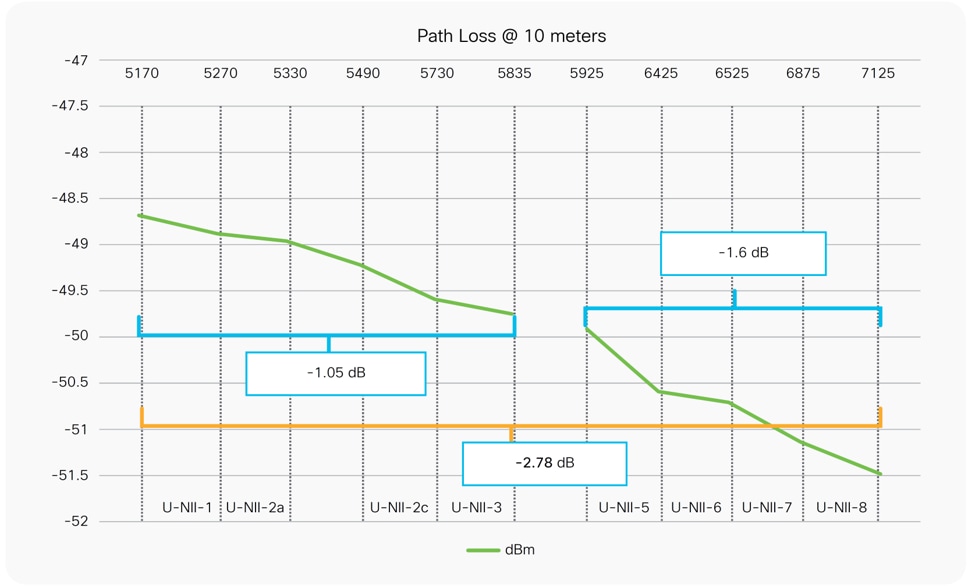
Difference in path loss between 5 GHz and 6 GHz
At 10 meters from an AP, the RSSI a client would see from an AP operating on channel 36 would be 1.05 dB higher than an AP operating on channel 157, assuming that both are transmitting at the same power. The difference in propagation loss is only 1.05 dB across the whole range. 6 GHz offers 1200 MHz (compared to 5 GHz’s 500 MHz) and as such loses a little more between the bottom of U-NII-5 and the top of U-NII-8, 1.6 dB across the range. In fact, the total drop is less than 3 dB from the beginning of U-NII-1 to the end of U-NII-8. For some perspective, in the U.S. the maximum allowed power between U-NII-2c and U-NII-3 is more than 3 dB.
What does this really mean for coverage? How big will a 6 GHz cell be, compared to a 5 GHz cell? The answer is “pretty much the same.” The figure below shows the modeling results of two simulated APs, each operating at maximum EIRP and an 80 MHz channel width. The one on the left is in 5 GHz, and the one on the right is in 6 GHz. To model the propagation accurately, the power was reduced by 1 dB to compensate for 6 GHz propagation loss.
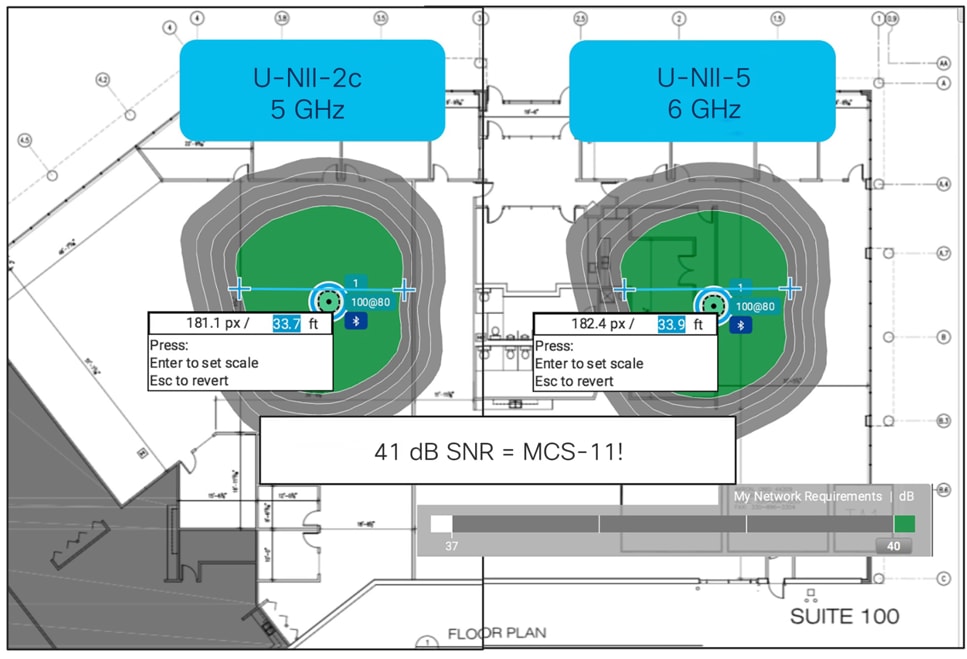
Comparison of coverage with simulated APs at 5 GHz (left) and 6 GHz (right)
At an 80 MHz channel width, the power levels for both were comparable, with the 5 GHz AP at 23 dBm and the 6 GHz AP at 24 dBm (reduced in the model to 23 dBm to simulate the additional loss).
Table 3. Simulation results
| Channel Bandwidth |
20 MHz |
40 MHz |
80 MHz |
160 MHz |
| 5 GHz, U-NII-2c |
23 dBm |
23 dBm |
23 dBm |
23 dBm |
| 6 GHz, U-NII-5 |
18 dBm |
21 dBm |
24 dBm |
27 dBm |
Both APs produce a 1250-square-foot cell, providing 41 dBm of SNR. At 41 dB of SNR, a two-spatial-stream Wi-Fi 6 client will support a data rate of MCS 11 (1201 Mbps). Given that the 6 GHz band should have a lower noise floor than the 5 GHz band does today, the advantages may even be greater for 6 GHz operations.
● See the Cisco Wi-Fi 6 solution
https://www.cisco.com/c/en/us/solutions/enterprise-networks/802-11ax-solution/index.html.
● Get the Network Infrastructure Upgrade Guide
https://www.cisco.com/c/m/en_us/solutions/enterprise-networks/infrastructure-upgrade-guide/mobility.html.